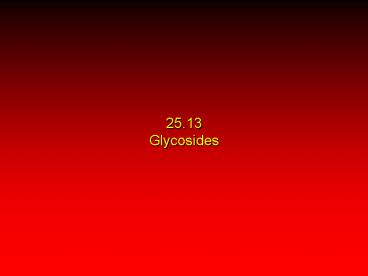25.13 Glycosides - PowerPoint PPT Presentation
Title:
25.13 Glycosides
Description:
HO. HO. HOCH2. CH2. NOSO3K. Glycosides. O-Glycosides are mixed acetals. ... HO. HO. HOCH2. Methyl. b-D-glucopyranoside. Methyl. a-D-glucopyranoside (major product) ... – PowerPoint PPT presentation
Number of Views:252
Avg rating:3.0/5.0
Title: 25.13 Glycosides
1
25.13Glycosides
2
Glycosides
- Glycosides have a substituent other than OH at
the anomeric carbon. - Usually the atom connected to the anomeric carbon
is oxygen.
3
Example
D-Glucose
- Linamarin is an O-glycoside derived from
D-glucose.
4
Glycosides
- Glycosides have a substituent other than OH at
the anomeric carbon. - Usually the atom connected to the anomeric carbon
is oxygen. - Examples of glycosides in which the atom
connected to the anomeric carbon is something
other than oxygen include S-glycosides and
N-glycosides.
5
Example
- Adenosine is an N-glycoside derived from D-ribose
D-Ribose
Adenosine
6
Example
D-Glucose
- Sinigrin is an S-glycoside derived from D-glucose.
7
Glycosides
- O-Glycosides are mixed acetals.
8
O-Glycosides are mixed acetals
hemiacetal
9
O-Glycosides are mixed acetals
hemiacetal
ROH
acetal
10
Preparation of Glycosides
- Glycosides of simple alcohols (such as methanol)
are prepared by adding an acid catalyst (usually
gaseous HCl) to a solution of a carbohydrate in
the appropriate alcohol. - Only the anomeric OH group is replaced.
- An equilibrium is established between the a and
b-glycosides (thermodynamic control). The more
stable stereoisomer predominates.
11
Preparation of Glycosides
CH3OH
HCl
D-Glucose
12
Preparation of Glycosides
Methylb-D-glucopyranoside
Methyla-D-glucopyranoside(major product)
13
Mechanism of Glycoside Formation
HCl
- carbocation is stabilized by lone-pair donation
from oxygen of the ring
14
Mechanism of Glycoside Formation
15
Mechanism of Glycoside Formation
16
25.14Disaccharides
17
Disaccharides
- Disaccharides are glycosides.
- The glycosidic linkage connects two
monosaccharides. - Two structurally related disaccharides are
cellobiose and maltose. Both are derived from
glucose.
18
Maltose and Cellobiose
a
Maltose
1
4
- Maltose is composed of two glucose units linked
together by a glycosidic bond between C-1 of one
glucose and C-4 of the other. - The stereochemistry at the anomeric carbon of the
glycosidic linkage is a. - The glycosidic linkage is described as a(1,4)
19
Maltose and Cellobiose
b
Cellobiose
- Cellobiose is a stereoisomer of maltose.
- The only difference between the two is that
cellobiose has a b(1,4) glycosidic bond while
that of maltose is a(1,4).
20
Maltose and Cellobiose
Cellobiose
Maltose
21
Cellobiose and Lactose
b
Cellobiose
- Cellobiose and lactose are stereoisomeric
disaccharides. - Both have b(1,4) glycosidic bonds.
- The glycosidic bond unites two glucose units in
cellobiose. It unites galactose and glucose in
lactose.
22
Cellobiose and Lactose
Lactose
- Cellobiose and lactose are stereoisomeric
disaccharides. - Both have b(1,4) glycosidic bonds.
- The glycosidic bond unites two glucose units in
cellobiose. It unites galactose and glucose in
lactose.
23
25.15Polysaccharides
24
Cellulose
- Cellulose is a polysaccharide composed of several
thousand D-glucose units joined by
b(1,4)-glycosidic linkages. Thus, it can also be
viewed as a repeating collection of cellobiose
units.
25
Cellulose
Four glucose units of a cellulose chain.
26
Starch
- Starch is a mixture of amylose and amylopectin.
- Amylose is a polysaccharide composed of 100 to
several thousand D-glucose units joined by
a(1,4)-glycosidic linkages.
27
25.16Cell-Surface Glycoproteins
28
Glycoproteins
- Glycoproteins have a protein backbone to which
carbohydrates are attached. One example is the
cell-surface glycoprotein that is recognized by
the influenza virus.
PROTEIN
29
Glycoproteins
- A second example is the group of glycoproteins
that define the various human blood groups.
30
Human-Blood-Group Glycoproteins
HO
CH2OH
O
N-Acetylgalactosaminepolymer
O
R
O
PROTEIN
O
H3C
O
OH
HO
HO
31
Type O
R
H
Type A
R
Type B
R































